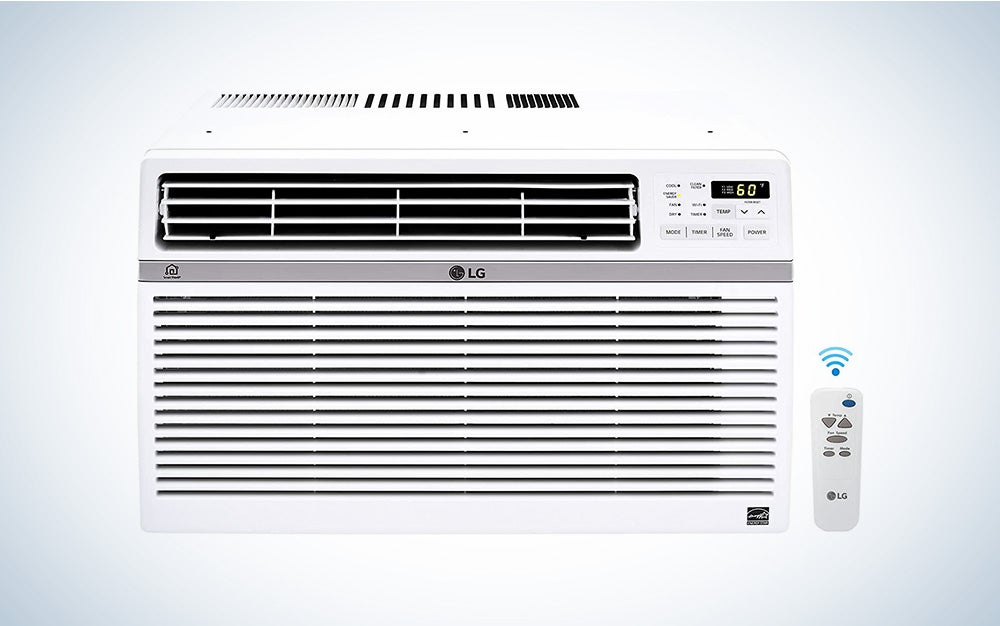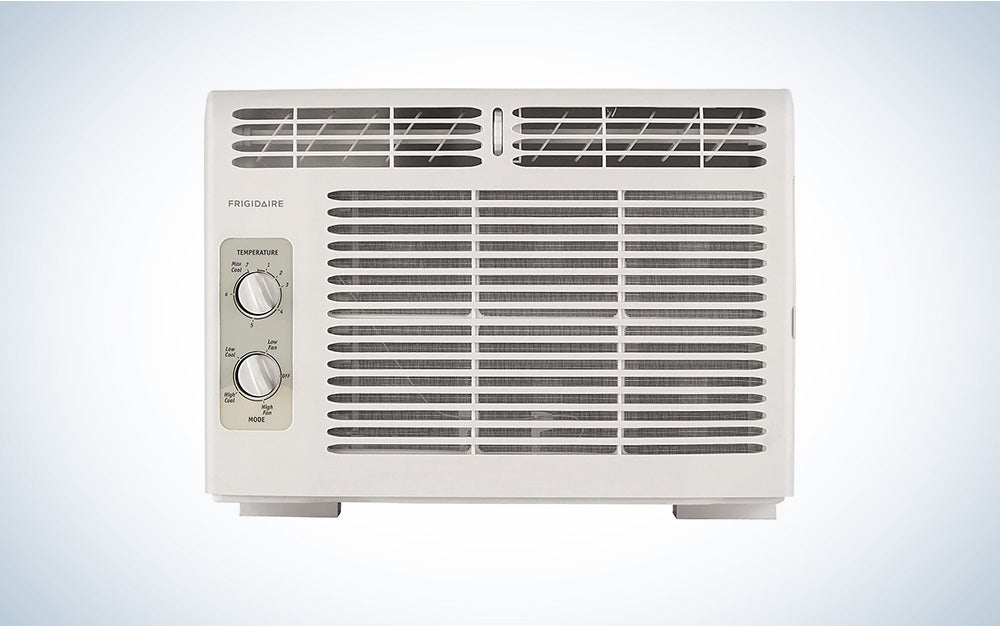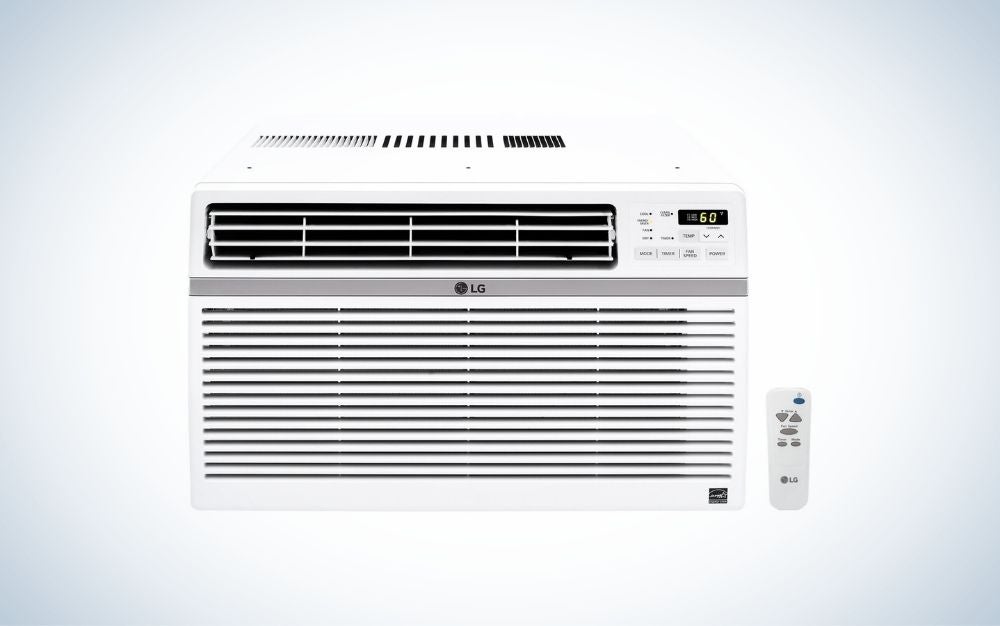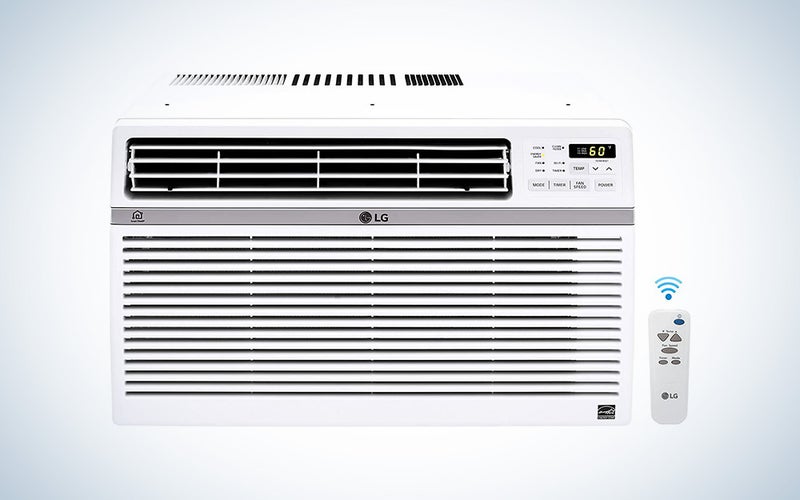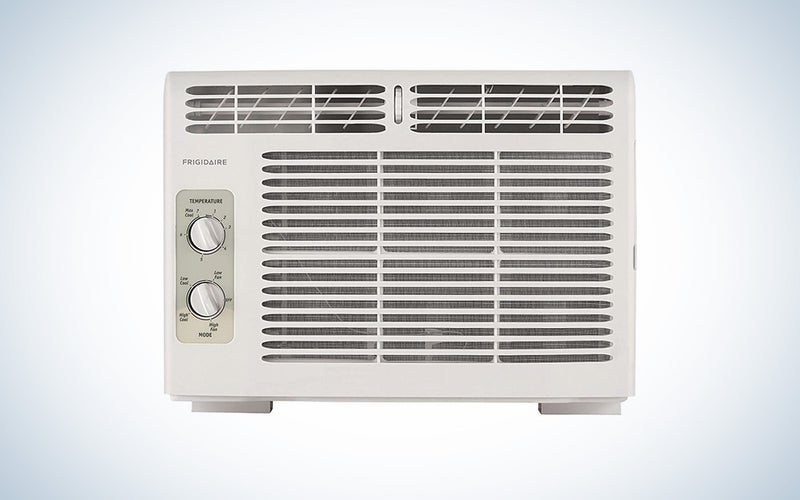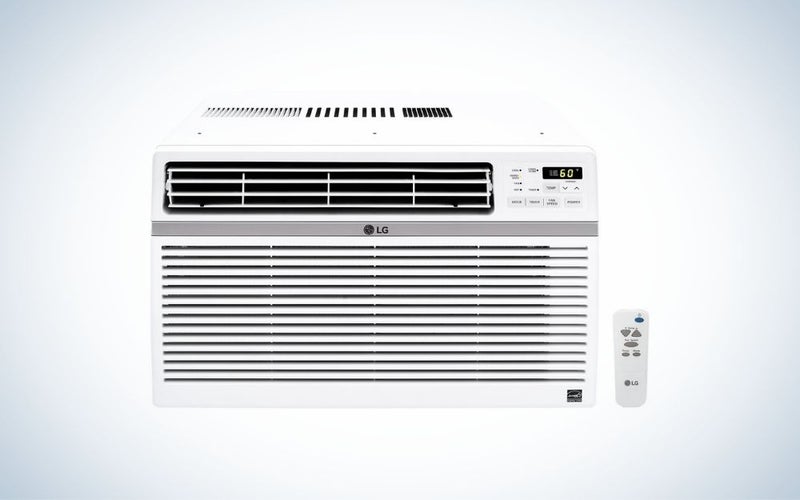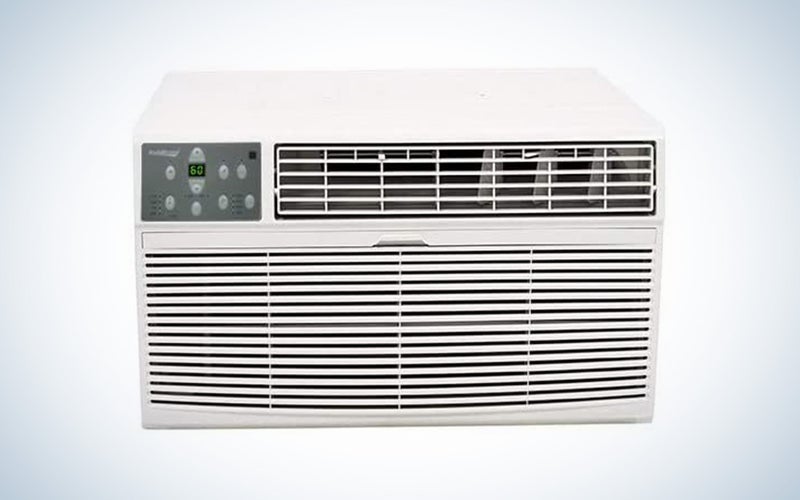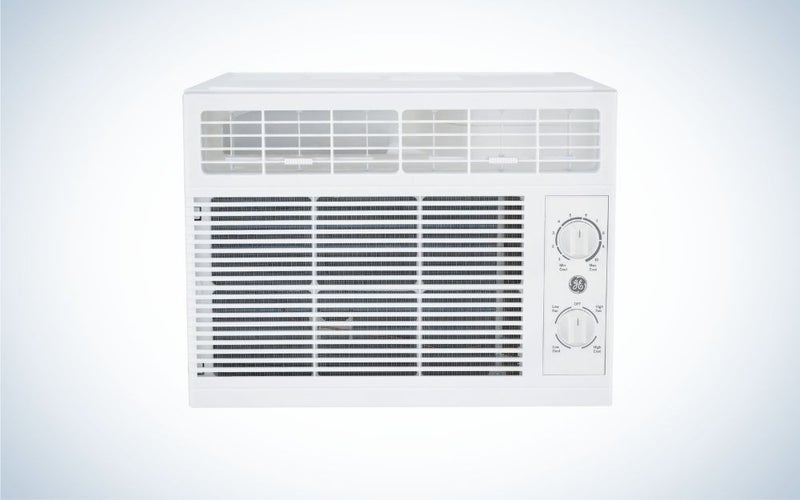We may earn revenue from the products available on this page and participate in affiliate programs. Learn more ›
When the numbers on the thermometer start ticking upward, it’s time to look into some cooling options. The best window air conditioners keep the sweat from running down your back and let you relax when it’s sweltering outside. These window AC units can fit inside horizontal or vertical sliding windows, so they don’t usually require any major home construction. In comparison to other cooling options, they are relatively affordable, too.
Window air conditioners don’t function like an HVAC. Each unit is designed to cool a specific square footage. To stay comfortable and prevent overtaxing the air conditioner, you need one that’s rated for the room size. We rounded up the best window air conditioners on the market, from smart models to mini-units, along with tips to pick the right unit for your home.
- Best smart window air conditioner: LG LW8017ERSM Smart Window Air Conditioner
- Best for small rooms: FRIGIDAIRE Mini-Compact Air Conditioner
- Best for large rooms: LG Window Air Conditioner
- Best air conditioner/heater combo: Koldfront WTC8001W Through the Wall Air Conditioner
- Best budget window air conditioner: GE Mechanical Window Air Conditioner
The lowdown on the best window air conditioners
Window air conditioners work by sucking in indoor air and circulating it over a cold metal coil. Refrigerant gas inside the coil absorbs heat. During the cooling process, the air also gets dehumidified as moisture vapor condenses onto the coil’s surface. It then trickles down the air conditioner and out of the appliance. Some units recycle the condensed water, using it to cool part of the coil. The air conditioner’s fan then blows the cool, dry air back into the room.
Look for an air conditioner with a high combined energy-efficiency ratio (CEER). The CEER rating shows the cooling capacity ratio measured in British Thermal Units (BTUs) relative to the electricity use. The air conditioner’s efficiency while running and when on standby are factored into this number. The higher the number, the better. Ratings can range between 8 to 22, though over time, some new units may get a higher rating.
Do you want smart features in your conditioner window unit?
Window ACs now have smart technology, just like almost every other major household appliance. Smart features offer some energy and money-saving benefits. However, smart features come with varying levels of usability.
Some models connect to an app on a smartphone or tablet. From the app, you can turn the air conditioner on or off, set a schedule, or adjust the cooling level. These smart features let you turn the air conditioner on 30 minutes before you get home from work or automatically shut it off 30 minutes after you leave for work. Of course, the app lets you use the phone or tablet as a remote, too.
Some units use smart technology to connect to a thermometer on the unit’s remote control. A remote placed in the center of the room more accurately represents the room’s temperature than a built-in thermometer that reads the temperature closest to the AC unit.
How much space do you have for your window air conditioner?
Small rooms, those under 200 square feet, don’t need the same BTUs as a unit that’s taking on a 500 square foot open floor plan. Mini air conditioner units designed for smaller areas are typically 4,000 to 6,000 BTU, depending on the design and features.
Air-conditioners need approximately 20 BTUs per square foot. To calculate the size you need, measure the room’s square footage (width times length) and multiply by 20. For example, a 15 x 15 room = 225 square feet x 20 = 4,500 BTUs. That’s an estimate. Check the air conditioner’s CEER and square footage the manufacturer has rated it for to make sure the air conditioner can cool the space you have in mind.
Window air conditioners with the BTUs for large spaces
Window air conditioners may be an add-on, but there are many models that can take on large spaces. These models have the BTUs and size to cool these spaces without overworking the unit. Some of these models have the power and capacity to cool a small house. That gets difficult if the house isn’t one big open space. However, it is possible.
Measure the space and estimate the needed BTUs using the same formula as that’s used for small rooms—room square footage x 20. These large units often offer premium features like multiple cooling and fan settings, multiple directional vents, or a dehumidifier setting. Check that the AC unit will fit in the window. These units are large, and you don’t want a unit that’s too big for the window.
Do you prefer all-in-one temperature control?
Your home can quickly get cluttered with appliances of various shapes and sizes. There are window air conditioning units that also function as a heater, offering dual uses to save space. These models aren’t usually as efficient as a designated air conditioner or heater. But if you’re short on space, they’re a space (and money) efficient way to control indoor temperatures.
Look for the same convenience features on these models as you do with other air-conditioners. Things like remote controls, smart features, and multiple fan speeds will make the unit more versatile and user-friendly.
Cooling on a budget
Window AC price often comes down to size and BTUs—smaller units with fewer BTUs cost less. Unfortunately, they don’t offer as much cooling power as larger, more expensive models.
Another way to save money on a window air conditioner is to skip fancy features like voice control, WiFi connectivity, and extra modes like a dehumidifier or fan-only settings. If you stick to the basics, you can get a reasonably affordable air conditioner for the room size.
Related: Not enough room for a window unit? Consider the best portable air conditioner.
The best window air conditioner
Best smart window air conditioner: LG LW8017ERSM Smart Window Air Conditioner
LG
The LG LW8017ERSM Smart Window Air Conditioner comes in the three BTU options: 8,000, 10,000, and 12,000 BTUs. The 10,000-BTU unit cools spaces up to 450 square feet. This model features onboard controls, a remote control, or smart control through an app. With the app, you can remotely turn the conditioner on or off from anywhere you can get a WiFi connection. It also includes three cooling and fan speeds, as well as compatibility with Alexa and Google for convenient voice control.
Best for small rooms: FRIGIDAIRE Mini-Compact Air Conditioner
Frigidaire
The FRIGIDAIRE Mini-Compact Air Conditioner keeps things tight with a small 15.24-inch x 16-inch x 12-inch size. The manufacturer recommends keeping its 5,000 BTUs to 150-square-foot spaces. That’s about the size of a small bedroom or kitchen. It also includes a washable filter that removes dust from the air as it cools. Onboard dial controls keep things simple and work well, even if there’s no remote control.
Best for large rooms: LG Window Air Conditioner
Walmart
The LG 24,500 BTU 230V Window Air Conditioner’s 24,500 BTUs take on spaces up to 1,560 square feet. However, it also provides premium features like four-way air deflection for targeted airflow, a dehumidifier setting, and fan-only mode. A 24-hour timer lets you customize the cooling schedule and will automatically shut the AC on and off.
Best air conditioner/heater combo: Koldfront Through the Wall Air Conditioner
Koldfront
The Koldfront Through the Wall Air Conditioner pulls double duty. Its 8,000 cooling BTUs chill spaces up to 350 square feet. However, when it’s chilly, it provides 4,200 BTUs for heating 100 square feet. That’s not enough to act as a complete heat source, but it can supplement baseboards or another heating method. This model also includes three fan speeds and four-way directional louvers to better circulate the air.
Best budget window air conditioner: GE Mechanical Window Air Conditioner
Walmart
The GE Mechanical Window Air Conditioner skips bells and whistles for an efficient 5000 BTUs. It cools spaces up to 150 square feet and monitors temperatures with an adjustable thermostat. The unit’s two cooling and fan speeds offer just enough adjustability for small spaces.
Related: Prefer a different way to cool down? The best portable fans will help you chill on a hot day.
FAQs
Q: How to choose a window air conditioner?
The most important factor when choosing a window air conditioner is the room size for which the unit is rated. You don’t want a unit that’s only designed to cool 150 square feet when you have a 400-square-foot room. You also want to look at the CEER rating. Ratings range anywhere from 9 to about 22. Most window air conditioners get a rating of 11 or 12. However, those with a rating of 14 or 15 bring extra efficiency and cooling power to your home.
Q: How long do window AC units last?
Window AC units can last as long as 25 years. They need regular maintenance and cleaning to keep them running at peak efficiency. Their lifespan also depends on how they’re used. A model that’s too small for the space it’s supposed to cool will overwork itself and wear out faster. The AC’s lifespan also depends on the settings. Low settings are less taxing than the fastest fan speed and coldest temperature setting.
Q: What size window AC unit do I need?
Look for a window air conditioner with the right BTUs for the room size. Use the following formula to estimate the necessary BTUs—room square-footage x 20 = BTUs. However, check the manufacturer’s recommendations for the unit’s approved room size. Some units have 5,000 BTUs but only cool a 150 square foot space.
Final thoughts on the best window air conditioners
A window AC unit can save you when the temperatures hit the triple digits. It’s worth paying for one of the best window air conditioners for their reliability, cooling power, and extra features. If you plan to use the air conditioner for years to come, consider investing in a high-quality unit with remote or smart control. However, the number-one factor to consider is the air conditioner’s BTUs and the square footage it can cool. Factor in the CEER to get an idea of its energy efficiency, too. Now go out and find the window AC that will let you chill in peace.

